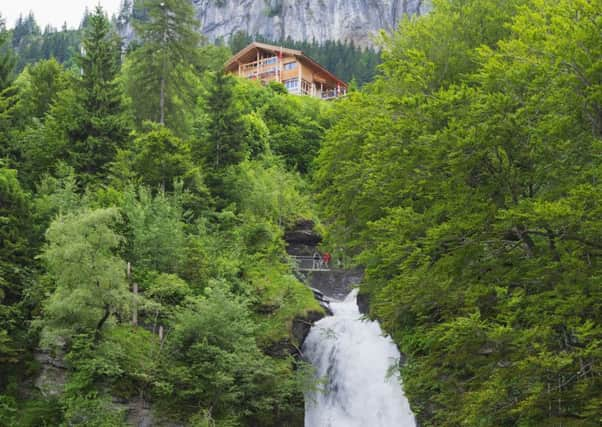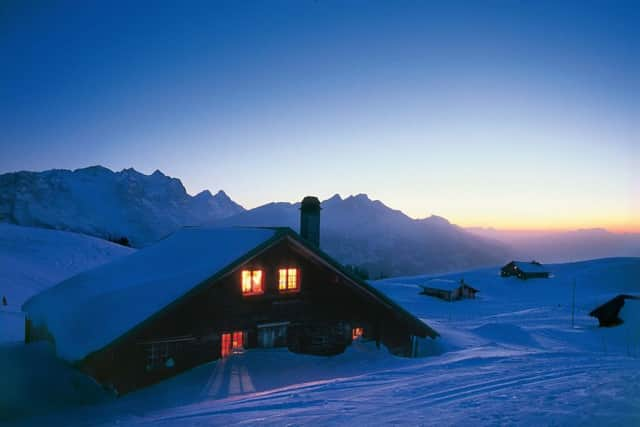Travel: A literary tour of Reichenbach, Switzerland


Next year is the 200th anniversary of the ‘Frankenstein summer’, when the paparazzi followed Byron, Shelley and their womenfolk – across Lake Geneva. Mary Shelley babysat and wrote Frankenstein. Byron dieted and penned The Prisoner of Chillon. His doctor, Polidori, was dreaming up The Vampyre. They stayed at the Hotel d’Angleterre in Secheron, which can still be seen today, and they put Switzerland on the literary map. From Hemingway to Hesse to Highsmith, writers have flocked there ever since. Today, travellers can go off-piste and explore a different side of that country: literary Switzerland.
Meiringen is a curious place for a Sherlock Holmes Museum, one of two in Switzerland. Arthur Conan Doyle killed off his detective here: Moriarty wrestled Holmes into the Reichenbach Falls.
Advertisement
Hide AdThe 34-year-old Edinburgh doctor came to Switzerland in August 1893 to give a series of talks in Lucerne. Perhaps it was Doyle’s final school year with the Jesuits at Feldkirch in Austria that gave him a taste for the Alps. A sporty doctor, he had seen skiing in Norway and imported one of the first pair of Norwegian skis to Davos, where like many others in the spa town, his wife was undergoing treatment for a spot on the lungs.


Together with the local Branger brothers, Doyle scaled the saddle of the Jacobshorn in the Albula range, now served by cable car and a snowboarder’s paradise. Since 2008 the area is a UNESCO World Heritage site, traversed by “lads leaping about on planks tied to their feet” (The Magic Mountain by Thomas Mann). The best way to see this snow country in luxury is from the comfort of the Swiss Railways Glacier Express which glides effortlessly and expensively through it.
Doyle wrote up his ski adventures for The Strand, the magazine that had been serialising his Holmes stories. “For a third of a mile we shot along over gently dipping curves, skimming down into the valley without a motion of our feet. In that great untrodden waste, with snow-fields bounding our vision on every side and no marks of life save the tracks of chamois and of foxes.”
The Edinburgh doctor predicted “the time will come when hundreds of Englishmen will come to Switzerland for a skiing season.” Time has proved him right.
Sherlock Holmes was a money-spinner. Conan Doyle had a love-hate relationship with him. “I think of slaying Holmes ... and winding him up for good and all. He takes my mind from better things,” the writer wrote to his mother in 1891. He attempted to kill off Holmes in The Final Problem, a story published in the December 1893 issue of The Strand while the author was safely wintering at Davos. It was an unwise decision. Like Agent Bond – another Scottish-Swiss brand, whose father hailed from Glencoe – Holmes has spawned TV spin-offs, films, museums and a wealth of merchandise. Both Bond and Holmes have the Swiss golden touch. Holmes has a thriving after-life on all our screens and in print a century and more since he plunged into the Reichenbach Falls.
Doyle stayed with his wife at the Hotel Parc du Sauvage in Meiringen, renaming it The Englischer Hof for his story. Holmes is the only fictional character to have been made an honorary citizen of Meiringen, with full voting rights.
Advertisement
Hide AdRenamed Conan Doyle Place in 1988, the village square proudly sports a statue of Holmes. The little faux-gothic English Church hosts a tiny museum featuring one of two Swiss replicas of 221b Baker Street. A plaque up on the Falls commemorates the detective’s demise.
Meiringen in winter can be colder than the back of a gravedigger’s shovel. Wind blows from Interlaken in one direction, and frosty alpine air from the Bernese Oberland in the other. Meiringen is a lonely place to die. Dirty snow littered the detective’s square when I visited. The bakeries were selling hazelnut tarts, a local specialty. Main Street was almost deserted and the hotel wasn’t serving lunch. Sheepskins were spread on the benches of the café beside the ice-rink.
Advertisement
Hide AdThe staff sat warming themselves in a Portakabin. I gave a visit to the fatal Falls a miss in favour of a slice of hazelnut tart and a hot chocolate.
In The Final Problem Holmes escapes from Victoria station disguised as an Italian priest. Watson is along for the ride in the first class carriage. Baker Street is in flames and Moriarty in hot pursuit.
“We reached the little village of Meiringen, where we put up at the Englischer Hof, then kept by Peter Steiler the elder. Our landlord was an intelligent man, and spoke excellent English, having served for three years as waiter at the Grosvenor Hotel in London. At his advice, on the afternoon of the 4th we set off together, with the intention of crossing the hills and spending the night at the hamlet of Rosenlaui.”
Doctor Watson treats an English lady at the hotel – a ploy, of course – while Moriarty tackles Holmes at the Falls. Watson realises his mistake and returns to find the detective’s walking stick leaning against the rock face.
Thousands of readers cancelled their subscriptions to The Strand magazine in December 1893 in protest and Doyle was obliged to resurrect his detective in a later story, The Adventure of the Empty House.
Robert Louis Stevenson was another Scottish writer who spent two successive winters in Davos, 1881 and 1882, with his wife Fanny and 12-year-old stepson Lloyd Osbourne. Stevenson completed Treasure Island there, in a winter of feverish work. The sun-loving author was disillusioned by the atmosphere of “death by gradual dry-rot, each in his indifferent inn”.
Advertisement
Hide AdLloyd Osbourne brought with him a small portable printing press, now on display at the Writers’ Museum in Edinburgh. The press, a gift from Stevenson, had travelled to Davos via San Francisco, Silverado and Edinburgh. It was used in Davos to print programmes for the weekly concerts at the Hotel Belvedere.
Stevenson wrote about Davos for the Pall Mall Gazette. “For about the health resort the walks are besieged by single people walking rapidly with plaids about their shoulders, by sudden troops of German boys trying to learn to jödel, and by German couples silently and, as you venture to fancy, not quite happily, pursuing love’s young dream.”
Advertisement
Hide AdLike Doyle, he was particularly taken by tobogganing. In Health and Mountains he brings the feverish world of the late 19th century Swiss sanatorium alive. “A village of hotels; a world of black and white – black pinewoods, clinging to the sides of the valley, and white snow flouring it, and papering it between the pinewoods ... add a few score invalids marching to and fro upon the snowy road, or skating on the ice rinks, possibly to music, or sitting under sunshades by the door of the hotel – and you have the larger features of a mountain sanatorium.’
Stevenson’s winters in Davos were marked by crisis and death. Fanny fell ill with kidney stones in December 1881 and was treated in Berne. They returned to Davos on Christmas Day in an open-air sleigh. “Seven hours on end through whole forests of Christmas trees. The cold was beyond belief. I have often suffered less at a dentist’s.” By their second spring they had had enough. Inveterate travellers and sun-worshippers, they settled for good in Samoa.
Alexander Fleming – another Scot – discovered penicillin in 1928 and as a consequence Davos emptied after the Second World War. Re-marketed as spas and wellness centres, the remaining sanatoria offered a full range of treatment, catering to what Ian Fleming calls “the modern managerial diseases”. Davos looked for new ways to market fresh air and snow. Skiing at nearby Klosters, taken up first by Doyle, became the sport of royalty in the last decades of the 20th century. That old magic, money, was back in town and the wealth managers were not far behind.
• The Gilded Chalet: Off-piste in Literary Switzerland by Padraig Rooney is published on Thursday by Nicholas Brealey, £20, hardback